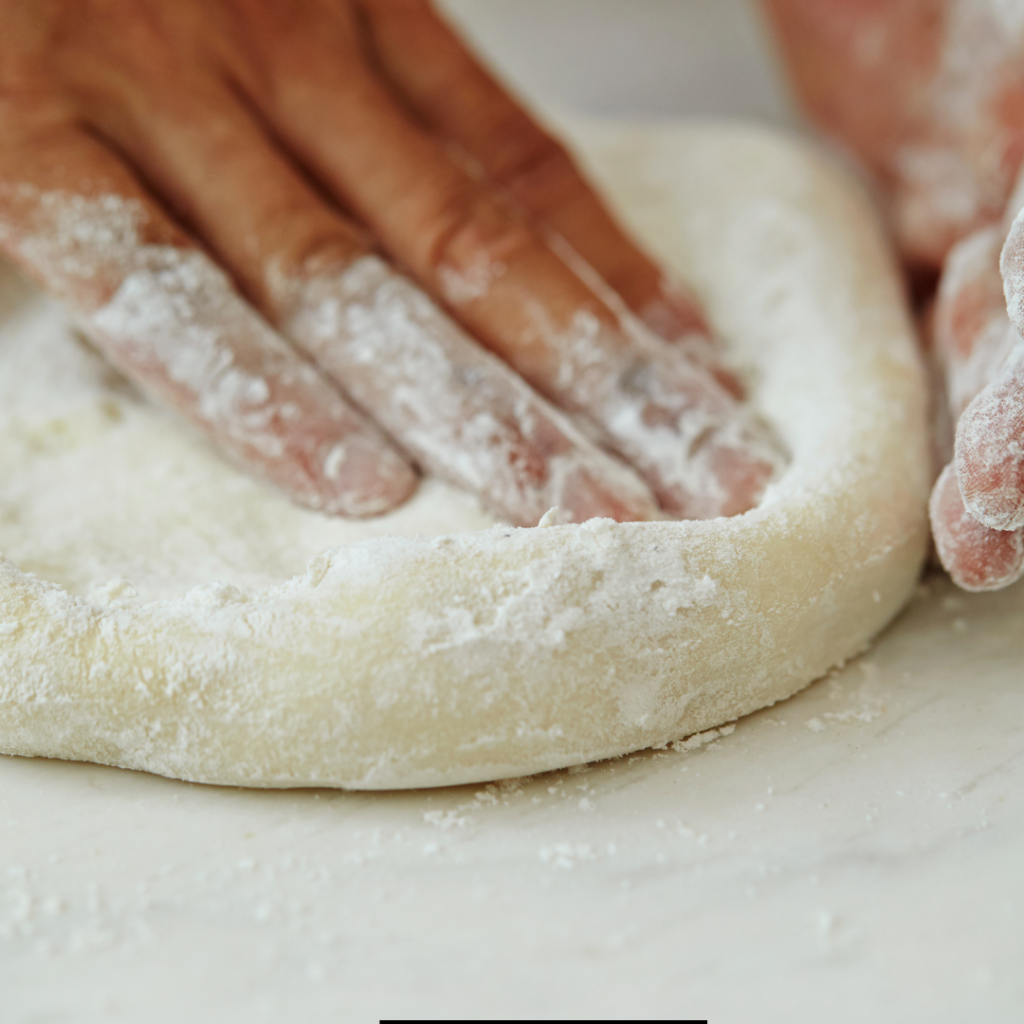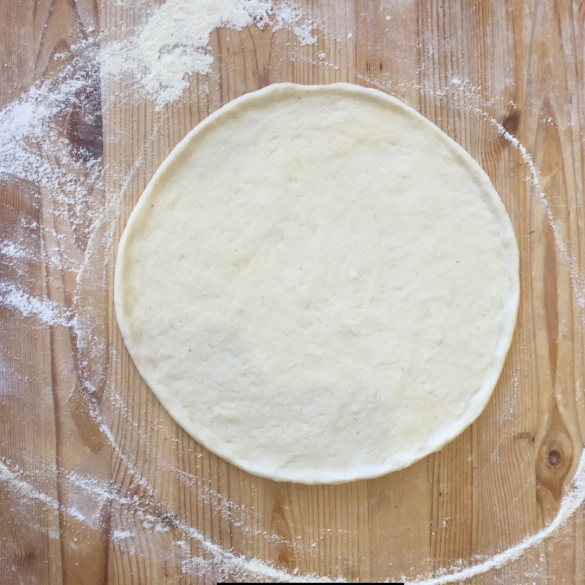Christopher Kimball’s Milk Street has long been a beacon of cooking inspiration, and it certainly didn’t disappoint with its take on pizza dough. This Milk Street Pizza Dough recipe, characterized by its simplicity, precision, and the sheer magic it brings to the table, promised an end to all my pizza crust woes. From measuring the ideal water temperature to understanding the perfect resting time, every step felt like I was being let in on a secret – one that would elevate my homemade pizza from good to unforgettable.
How to make Milk Street Pizza Dough
Milk Street Pizza Dough is a recipe developed by Christopher Kimball’s Milk Street, known for its focus on straightforward, accessible cooking. The dough is designed to be easy to make and handle, resulting in a flavorful and versatile base for homemade pizzas.
Ingredients
- 2 cups (250 grams) of all-purpose flour (bread flour works as a substitute for a chewier texture)
- 1 teaspoon of sugar
- 1/2 teaspoon of instant or rapid-rise yeast
- 3/4 teaspoon of table salt
- 2/3 cup (160 milliliters) of water (at about 100°F to 110°F)
- 1 tablespoon of extra-virgin olive oil, plus more for drizzling
Instructions
- Combine Dry Ingredients: In a food processor, mix together the flour, sugar, yeast, and salt, ensuring that they are thoroughly blended.
- Add Water and Oil: With the processor running, carefully add the warm water and the tablespoon of olive oil. Continue processing until the dough forms a rough ball that clears the sides of the bowl, which usually takes about 30 to 40 seconds. If the dough appears too sticky, add flour one tablespoon at a time. Conversely, if it’s too dry, incorporate water in small increments.
- Kneading: Once a ball forms, transfer the dough to a lightly floured surface. Knead briefly for about 1 minute to ensure it’s smooth and elastic.
- Resting the Dough: Shape the dough into a neat ball and place it in a lightly oiled bowl, covering it with plastic wrap. Let the dough rest at room temperature until it has doubled in size. This step is crucial for developing flavor and texture and typically takes about 1 to 2 hours, depending on the ambient temperature.
- Preparation for Baking: After the dough has risen, place it on a lightly floured surface. Divide it if necessary (depending on the recipe’s yield) and shape it gently into a round disc. Be careful not to overwork the dough at this stage to preserve its delicate structure.
- Final Rise: Let the shaped dough rest for an additional 20 minutes under a kitchen towel. This allows for a final rise and relaxes the gluten, making the dough easier to shape.
- Shaping: Gently stretch the dough into your desired shape using your hands or a rolling pin, being mindful not to deflate it. Aim for an even thickness to ensure uniform cooking.
- Baking: Preheat your oven, with a pizza stone or inverted baking sheet inside, to the highest setting, typically between 475°F to 500°F. Transfer your shaped dough onto the hot surface and add your preferred toppings. Bake until the crust is golden brown and the cheese (if used) is bubbling—approximately 10 to 15 minutes, depending on your oven.
Tips for Success
- Water Temperature: Using water that’s too hot can kill the yeast, while too cold water won’t activate it sufficiently. Aim for that 100°F to 110°F sweet spot for best results.
- Dough Handling: Handle the dough gently, especially during the shaping phase, to maintain the air bubbles contributing to its texture.
- Preheat Your Baking Surface: A hot pizza stone or baking sheet mimics the environment of a professional pizza oven and helps achieve a crispy bottom crust.
- Experiment with Toppings: While the dough is the foundation, the toppings can transform each pizza into a unique creation. Just be careful not to overload it, which will result in a soggy crust.
Ingredient Substitutes

Milk Street pizza dough recipe, like most pizza dough recipes, is relatively flexible when it comes to ingredients and can be adjusted based on what you have in your pantry or to accommodate dietary preferences and restrictions. Here’s how you can substitute some of the commonly used ingredients in pizza dough:
Flour
All-purpose flour can be replaced by:
- Bread flour: Its higher protein content will give your pizza dough a chewier and more bread-like texture.
- Whole wheat flour: Use it for a nuttier flavor and more fiber. It’s typically denser, so you might need to adjust liquid amounts and expect a heavier Milk Street Pizza Dough.
- Gluten-free flour blends: Choose a blend designed to mimic the properties of wheat flour. These will usually include xanthan gum or another binder to imitate the stretchiness of gluten.
Yeast
Active dry yeast can be replaced by:
- Instant yeast (also known as rapid-rise yeast): Use the same amount. It doesn’t need to be activated in warm water and can be mixed directly with the dry ingredients.
- Fresh yeast: If you choose to use fresh yeast, remember that you’ll need roughly three times the weight of fresh yeast as you would active dry yeast or instant yeast.
Salt
Table salt can be replaced by:
- Sea salt: Use an equivalent amount. Finely ground sea salt is often less dense, so if using coarser grains, you may want to use a grinder or mortar and pestle to break it down so it distributes more evenly in your dough.
- Kosher salt: If using kosher salt, you may need to adjust the quantity, as it is coarser and less salty by volume than table salt. As a general rule, use about 1.5 times more kosher salt.
Oil
Olive oil can be replaced by:
- Neutral oils like canola or vegetable oil: If you prefer a dough with less pronounced flavor or if you’re out of olive oil, these oils are fine substitutes. The texture will be similar, but the flavor will be more neutral.
- Infused olive oils: You can use garlic-infused or herb-infused olive oils for added flavors.
Sugar
Granulated sugar can be replaced by:
- Honey: Adding a little bit of honey can substitute the sugar required to activate the yeast and will impart a mild sweetness to the dough.
- Maple syrup: Another natural sweetener option that can add a different flavor profile to your dough.
- Agave nectar: Like honey, it’s sweeter than sugar, so you might want to use less.
Final Thoughts
Follow these detailed steps and tips, and the Milk Street Pizza Dough recipe will bring you a pizza and an experience to be savored and shared.
More Pizza Recipes:

Ingredients
- 2 cups (250 grams) of all-purpose flour
- 1 teaspoon of sugar
- 1/2 teaspoon of instant or rapid-rise yeast
- 3/4 teaspoon of table salt
- 2/3 cup (160 milliliters) of water (at about 100°F to 110°F)
- 1 tablespoon of extra-virgin olive oil, plus more for drizzling
Instructions
- Combine Dry Ingredients: In a food processor, mix together the flour, sugar, yeast, and salt, ensuring that they are thoroughly blended.
- Add Water and Oil: With the processor running, carefully add the warm water and the tablespoon of olive oil. Continue processing until the dough forms a rough ball that clears the sides of the bowl, which usually takes about 30 to 40 seconds. If the dough appears too sticky, add flour one tablespoon at a time. Conversely, if it's too dry, incorporate water in small increments.
- Kneading: Once a ball forms, transfer the dough to a lightly floured surface. Knead briefly for about 1 minute to ensure it's smooth and elastic.
- Resting the Dough: Shape the dough into a neat ball and place it in a lightly oiled bowl, covering it with plastic wrap. Let the dough rest at room temperature until it has doubled in size. This step is crucial for developing flavor and texture and typically takes about 1 to 2 hours, depending on the ambient temperature.
- Preparation for Baking: After the dough has risen, place it on a lightly floured surface. Divide it if necessary (depending on the recipe's yield) and shape it gently into a round disc. Be careful not to overwork the dough at this stage to preserve its delicate structure.
- Final Rise: Let the shaped dough rest for an additional 20 minutes under a kitchen towel. This allows for a final rise and relaxes the gluten, making the dough easier to shape.
- Shaping: Gently stretch the dough into your desired shape using your hands or a rolling pin, being mindful not to deflate it. Aim for an even thickness to ensure uniform cooking.
- Baking: Preheat your oven, with a pizza stone or inverted baking sheet inside, to the highest setting, typically between 475°F to 500°F. Transfer your shaped dough onto the hot surface and add your preferred toppings. Bake until the crust is golden brown and the cheese (if used) is bubbling—approximately 10 to 15 minutes, depending on your oven.
